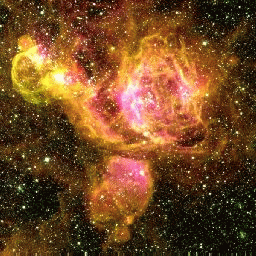
Roger Leiton-Thompson
SUPERNOVA REMNANTS IN THE LMC
INTERESTS & PROJECTS:
- Magellanic Cloud Emission-line Survey (MCELS)
- Supernova Remnants in the LMC
- NASA's Space Interferometry Mission (SIM):
Galactic Globular Clusters
- Light Pollution and Sky Brightness
- Chilean Section of the International Dark-Sky Association (IDA-Chile)
- Astronomy Outreach:
International Year of Astronomy 2009 in Chile.
My CV (June 2007)
Publications in ADS
Talks and outreach material (mostly in Spanish):
- Efecto Casimir
- Supernovas, Aficionados y el destino del Universo
- Contaminacion Luminica
Last Update:
August 2007
INTRODUCTION:
Supernovae (SNe) and their remnants are the driving force behind the dynamic interstellar medium (ISM) of our Galaxy and others. The study of the energetics and evolution of the SNRs thus forms the foundation for developing a complete understanding of the complex structure and evolution of the ISM in most of galaxies.
An existing canonical sample of 32 SNRs in the LMC (Mathewson et al. 1983, 1984, 1985) is woefully incomplete (e.g., Helfand 1984). Toward the goal of increasing the known SNR sample in the LMC, we have identified new SNRs. and SNR candidates using data from the MCELS and begun the process of confirming their nature with multi-wavelength spectroscopic and imaging data. These newly confirmed SNRs are generally fainter than the canonical sample in the LMC and may represent a previously missed population. Not surprisingly, we are finding SNRs which have been passed over unnoticed in previous surveys at all wavelengths, including the two largest SNRs found until now in the LMC (J0550-683; J0506-6541 see Points et al. poster[101.07]).
OPTICAL DETECTION OF CANDIDATES:
As we complete the reduction and begin the full analysis of the MCELS dataset, we are uncovering a host of new SNR candidates based on the reliable [S II]/Halpha line ratio, high values of which are a recognized shock diagnostic. Optical emission-line surveys of more distant galaxies (e.g., D'Odorico et al. 1980, Long et al. 1990, Smith et al. 1993, Matonick & Fesen 1997) have been extremely successful at identifying large samples of SNRs, but those remnants are difficult to study given the much larger distances involved. To date MCELS represents the first project to completely survey the LMC in Halpha and [S II] with the same digital techniques so successfully used in the studies of more distant galaxies.
SNR candidates are found inspecting the [S II]/Halpha ratio images constructed from the calibrated MCELS dataset. Low-resolution spectroscopic observations with a spectral coverage from about 4800A to 6800A are made using the CTIO 1.5m telescope to obtain a preliminary confirmation of the candidate and to improve the flux calibration of the images using the spectra [S II]/H ratio.
Colour images of the confirmed SNR and candidates are ~10”x10” in size, equivalent to 144x144 pc or 260x260 pixel.
MULTI-WAVELENGTH FOLLOW-UP:
The combination of additional multi-wavelength observations with the optical emission-line images of the MCELS dataset is leading to the confirmation and study of the nature of the SNR candidates. Spectral information is obtained using the Echelle high-resolution spectrograph mounted in the CTIO Blanco 4-m and low-resolution spectra using the R-C spectrograph with the CTIO1.5-m telescope. In X-rays, ROSAT images has been previously used with success for this task and XMM-Newton observations are also providing information about the physical structure and evolution of these new SNRs (See Points et a. [101.07]). In radio, observations from the Australian Telescope Compact Array (ATCA) are also used to complete the wavelength coverage.
STUDYING SNRs IN THE MCs:
As we mention, narrow-band MCELS images allow us to detect and select the most remarkable objects. Low-resolution spectra provide us a preliminary confirmation of the SNR nature and also an exploratory calculation of some physical properties as the Sulfur Ratio R([S II]), the electronic density ne based on the R([S II]). From Echelle high-resolution spectra, velocities (Vexp) of the expanding SNR structure can be obtained. Introducing these observable quantities, ne, Vexp,and the optical radius in theoretical models, preliminary calculations of the initial energy of the SN explosion can be estimated.
An example of this are the measurements for five of six new MCELS SNRs reported recently by Smith et al. 2004.
On the other hand, X-ray data can reveal important information about the physical processes occurring in the SNR, tracing both the hot gas immediately behind the shock front (including the reverse shock, which predominates in younger SNRs) and in some cases, that in the central cavity. For instance, cloudlet evaporation in an SNR interior can raise the density of the hot gas, thus raising the X-ray surface brightness of the hot interior to observable levels. This phenomenon is an example which shows that the X-ray morphology can be a useful tool for diagnosing the physical properties of a SNR. Points et al. poster[101.07] examine the physical structure and conditions of two of our newly discovered SNRs in the LMC using XMM-Newton observations. Seward et al. poster [101.05] reports the use of Chandra X-ray data and the narrow-band MCELS images to analyze the case of the SNR 0454-672 in N9.
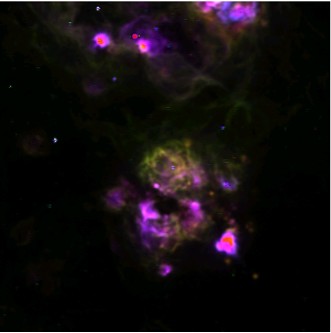 |
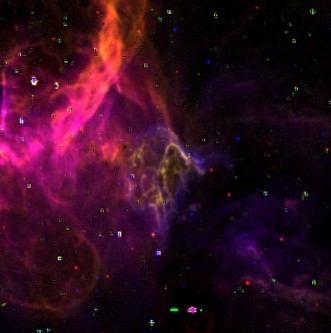 |
| MCELS
J0540-697 |
SNR in
N9 |
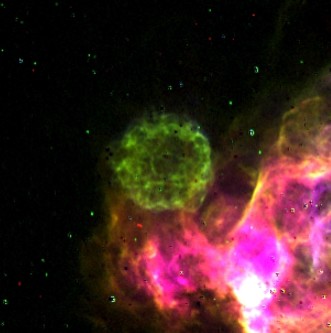 |
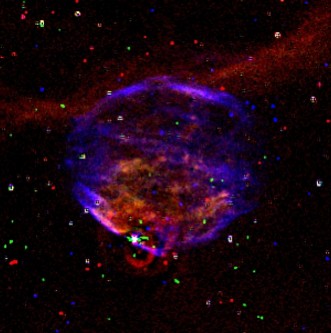 |
| SNR
in N206 |
MCELS
J0550-683 |
Recently, Williams et al. (2004) presented the case of the SNR 0450 -70.9 in the LMC using optical MCELS data, Echelle high-resolution spectra, ATCA and XMM-Newton observations. The detection of significant X-ray emission, in conjunction with the optical and radio data, over the face of this SNR has provided a rare opportunity to directly test models of late-stage SNR development against the data. Although the preliminary analysis allows wide chance for error, it is possible to show that one such set of models is consistent with the data for reasonable choices of physical parameters.
SELECTED REFERENCES:
D'Odorico, S. et al., 1980, A&AS, 40, 67
Helfand, D.J., 1984, in IAU Symposium 108: Structure and Evolution of the Magellanic Cloud, 293
Long, K. S. et al., 1990, ApJS, 72, 61
Mathewson, D. S. et al., 1983, ApJS, 51, 345
Mathewson, D. S. et al., 1984, ApJS, 55, 189
Mathewson, D. S. et al., 1985, ApJS, 58, 197
Matonic D.M. & Fesen, R.A., 1997, ApJS, 112, 49.
Smith, R. C., et al., 2004, AAS Meeting.
Smith, R.C., et al., 1993, ApJ, 407,564.
Williams et al., 2004, ApJ, 613, 948.